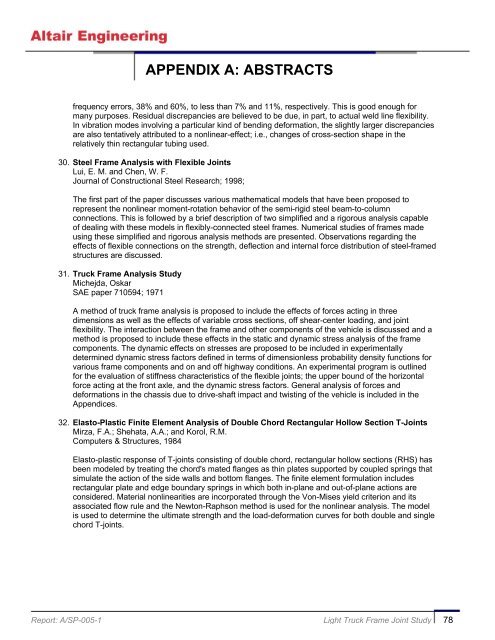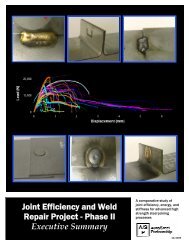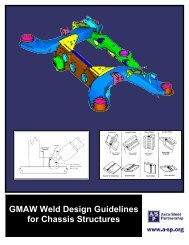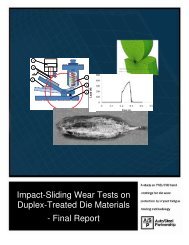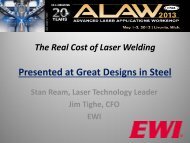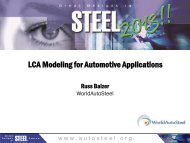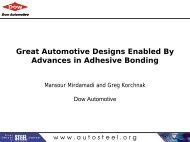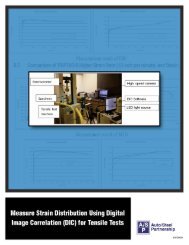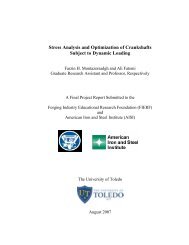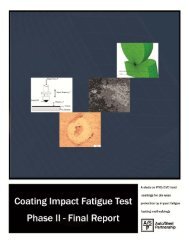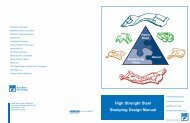Light Truck Frame Joint Stiffness Study Phase 1 Final Report
Light Truck Frame Joint Stiffness Study Phase 1 Final Report
Light Truck Frame Joint Stiffness Study Phase 1 Final Report
Create successful ePaper yourself
Turn your PDF publications into a flip-book with our unique Google optimized e-Paper software.
APPENDIX A: ABSTRACTS<br />
frequency errors, 38% and 60%, to less than 7% and 11%, respectively. This is good enough for<br />
many purposes. Residual discrepancies are believed to be due, in part, to actual weld line flexibility.<br />
In vibration modes involving a particular kind of bending deformation, the slightly larger discrepancies<br />
are also tentatively attributed to a nonlinear-effect; i.e., changes of cross-section shape in the<br />
relatively thin rectangular tubing used.<br />
30. Steel <strong>Frame</strong> Analysis with Flexible <strong>Joint</strong>s<br />
Lui, E. M. and Chen, W. F.<br />
Journal of Constructional Steel Research; 1998;<br />
The first part of the paper discusses various mathematical models that have been proposed to<br />
represent the nonlinear moment-rotation behavior of the semi-rigid steel beam-to-column<br />
connections. This is followed by a brief description of two simplified and a rigorous analysis capable<br />
of dealing with these models in flexibly-connected steel frames. Numerical studies of frames made<br />
using these simplified and rigorous analysis methods are presented. Observations regarding the<br />
effects of flexible connections on the strength, deflection and internal force distribution of steel-framed<br />
structures are discussed.<br />
31. <strong>Truck</strong> <strong>Frame</strong> Analysis <strong>Study</strong><br />
Michejda, Oskar<br />
SAE paper 710594; 1971<br />
A method of truck frame analysis is proposed to include the effects of forces acting in three<br />
dimensions as well as the effects of variable cross sections, off shear-center loading, and joint<br />
flexibility. The interaction between the frame and other components of the vehicle is discussed and a<br />
method is proposed to include these effects in the static and dynamic stress analysis of the frame<br />
components. The dynamic effects on stresses are proposed to be included in experimentally<br />
determined dynamic stress factors defined in terms of dimensionless probability density functions for<br />
various frame components and on and off highway conditions. An experimental program is outlined<br />
for the evaluation of stiffness characteristics of the flexible joints; the upper bound of the horizontal<br />
force acting at the front axle, and the dynamic stress factors. General analysis of forces and<br />
deformations in the chassis due to drive-shaft impact and twisting of the vehicle is included in the<br />
Appendices.<br />
32. Elasto-Plastic Finite Element Analysis of Double Chord Rectangular Hollow Section T-<strong>Joint</strong>s<br />
Mirza, F.A.; Shehata, A.A.; and Korol, R.M.<br />
Computers & Structures, 1984<br />
Elasto-plastic response of T-joints consisting of double chord, rectangular hollow sections (RHS) has<br />
been modeled by treating the chord's mated flanges as thin plates supported by coupled springs that<br />
simulate the action of the side walls and bottom flanges. The finite element formulation includes<br />
rectangular plate and edge boundary springs in which both in-plane and out-of-plane actions are<br />
considered. Material nonlinearities are incorporated through the Von-Mises yield criterion and its<br />
associated flow rule and the Newton-Raphson method is used for the nonlinear analysis. The model<br />
is used to determine the ultimate strength and the load-deformation curves for both double and single<br />
chord T-joints.<br />
<strong>Report</strong>: A/SP-005-1 <strong>Light</strong> <strong>Truck</strong> <strong>Frame</strong> <strong>Joint</strong> <strong>Study</strong> 78


